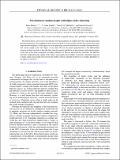Files in this item
Percolation in random graphs with higher-order clustering
Item metadata
| dc.contributor.author | Mann, Peter Stephen | |
| dc.contributor.author | Smith, V Anne | |
| dc.contributor.author | Mitchell, John B. O. | |
| dc.contributor.author | Dobson, Simon Andrew | |
| dc.date.accessioned | 2021-03-11T13:30:04Z | |
| dc.date.available | 2021-03-11T13:30:04Z | |
| dc.date.issued | 2021-01-25 | |
| dc.identifier | 272145783 | |
| dc.identifier | c9c89a1d-2cc8-453f-88f6-63b6a4641e84 | |
| dc.identifier | 85100406500 | |
| dc.identifier | 000612141200008 | |
| dc.identifier.citation | Mann , P S , Smith , V A , Mitchell , J B O & Dobson , S A 2021 , ' Percolation in random graphs with higher-order clustering ' , Physical Review. E, Statistical, nonlinear, and soft matter physics , vol. 103 , no. 1 , 012313 . https://doi.org/10.1103/PhysRevE.103.012313 | en |
| dc.identifier.issn | 1539-3755 | |
| dc.identifier.other | ORCID: /0000-0002-0379-6097/work/89627240 | |
| dc.identifier.other | ORCID: /0000-0002-0487-2469/work/89627950 | |
| dc.identifier.other | ORCID: /0000-0001-9633-2103/work/89628343 | |
| dc.identifier.uri | https://hdl.handle.net/10023/21613 | |
| dc.description | Funding: We acknowledge the School of Chemistry and the School of Biology of the University of St Andrews for the funding contributions for this work. | en |
| dc.description.abstract | Percolation theory can be used to describe the structural properties of complex networks using the generating function formulation. This mapping assumes that the network is locally treelike and does not contain short-range loops between neighbors. In this paper we use the generating function formulation to examine clustered networks that contain simple cycles and cliques of any order. We use the natural generalization to the Molloy-Reed criterion for these networks to describe their critical properties and derive an approximate analytical description of the size of the giant component, providing solutions for Poisson and power-law networks. We find that networks comprising larger simple cycles behave increasingly more treelike. Conversely, clustering composed of larger cliques increasingly deviate from the treelike solution, although the behavior is strongly dependent on the degree-assortativity. | |
| dc.format.extent | 11 | |
| dc.format.extent | 648994 | |
| dc.language.iso | eng | |
| dc.relation.ispartof | Physical Review. E, Statistical, nonlinear, and soft matter physics | en |
| dc.subject | QA75 Electronic computers. Computer science | en |
| dc.subject | QD Chemistry | en |
| dc.subject | QH301 Biology | en |
| dc.subject | T-NDAS | en |
| dc.subject.lcc | QA75 | en |
| dc.subject.lcc | QD | en |
| dc.subject.lcc | QH301 | en |
| dc.title | Percolation in random graphs with higher-order clustering | en |
| dc.type | Journal article | en |
| dc.contributor.institution | University of St Andrews. School of Chemistry | en |
| dc.contributor.institution | University of St Andrews. Office of the Principal | en |
| dc.contributor.institution | University of St Andrews. St Andrews Centre for Exoplanet Science | en |
| dc.contributor.institution | University of St Andrews. Centre for Biological Diversity | en |
| dc.contributor.institution | University of St Andrews. Scottish Oceans Institute | en |
| dc.contributor.institution | University of St Andrews. Institute of Behavioural and Neural Sciences | en |
| dc.contributor.institution | University of St Andrews. School of Biology | en |
| dc.contributor.institution | University of St Andrews. St Andrews Bioinformatics Unit | en |
| dc.contributor.institution | University of St Andrews. EaSTCHEM | en |
| dc.contributor.institution | University of St Andrews. Biomedical Sciences Research Complex | en |
| dc.contributor.institution | University of St Andrews. School of Computer Science | en |
| dc.contributor.institution | University of St Andrews. Sir James Mackenzie Institute for Early Diagnosis | en |
| dc.identifier.doi | 10.1103/PhysRevE.103.012313 | |
| dc.description.status | Peer reviewed | en |
| dc.identifier.url | https://arxiv.org/abs/2006.06744 | en |
This item appears in the following Collection(s)
Items in the St Andrews Research Repository are protected by copyright, with all rights reserved, unless otherwise indicated.

